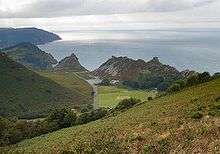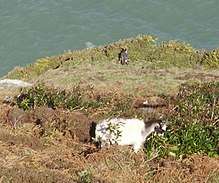Valley of Rocks
The Valley of Rocks,[1] or (less correctly) Valley of the Rocks, is a dry valley that runs parallel to the coast in north Devon, England, about 1 kilometre (0.6 mi) to the west of the village of Lynton. It is a popular tourist destination, noted for its herd of feral goats,[2] and for its landscape and geology.



Geology and landscape
The valley has good exposures of the Lynton Beds (formally the 'Lynton Formation') that are among the oldest Devonian rocks in north Devon and are highly fossiliferous. Also of note are the periglacial features formed when this area was at the limit of glaciation during the last Ice Age.[3] The valley is believed to owe its existence to the dissection by coastal cliff recession of a former extension of the valley of the East Lyn River which now meets the sea at Lynmouth.[4]
Literary and musical connections
In late 1797, Samuel Taylor Coleridge and William Wordsworth visited the valley together and decided to write a prose tale called "The Wanderings of Cain" set there, though it was never completed.[5][6] The poet Robert Southey was a visitor in August 1799, and was impressed, describing it as "covered with huge stones … the very bones and skeletons of the earth; rock reeling upon rock, stone piled upon stone, a huge terrific mass".[7] In her poem on the subject (1831), Letitia Elizabeth Landon views the place as suitable for the unhappy, but, as she puts it "Gloomy vale! if thou couldst be haunt for human misery, half our life were spent with thee". Later, R. D. Blackmore set part of his novel Lorna Doone (first published in 1869) in the valley.[8]
| Wikisource has original text related to this article: |
A visit to the area in 1974 by the Australian composer Miriam Hyde with her husband led to her writing the piano piece Valley of Rocks in 1975, which became her best-known composition.

References
| Wikimedia Commons has media related to Valley of the Rocks, Devon. |
- Authority, Exmoor National Park (2017-09-05). "Valley of Rocks". Exmoor. Retrieved 2020-05-21.
- "Poisoned peppers meant for goats". BBC News. 20 March 2007. Retrieved 2009-09-03.
- "Geology to see in Northern Devon and Exmoor". Devon County Council. Archived from the original on 2015-09-11. Retrieved 2009-09-03.
- Durrance, E. M.; Laming, D. J. (1982). The Geology of Devon. University of Exeter. pp. 259, 289. ISBN 0-85989-247-6.
- "Samuel Taylor Coleridge and Exmoor". Exmoor National Park Authority. Archived from the original on 2009-09-04. Retrieved 2009-09-05.
- "Coleridge - "Wanderings of Cain" - Electronic Editions - Romantic Circles". University of Maryland. Retrieved 2009-09-05.
- "Robert Southey and Exmoor". Exmoor National Park Authority. Archived from the original on 2009-08-23. Retrieved 2009-09-05.
- "Lorna Doone, by R. D. Blackmore (chapter 17)". The University of Adelaide Library. Retrieved 2009-09-05.